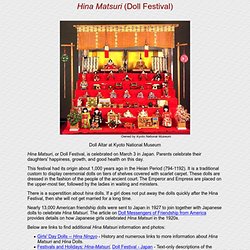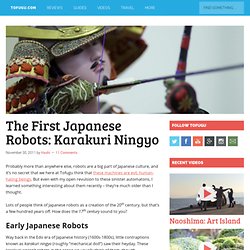

Language. Official Osaka Site. Hina Matsuri (Doll Festival) Owned by Kyoto National Museum Doll Altar at Kyoto National Museum Hina Matsuri, or Doll Festival, is celebrated on March 3 in Japan.

Parents celebrate their daughters' happiness, growth, and good health on this day. The First Japanese Robots: Karakuri Ningyo. Probably more than anywhere else, robots are a big part of Japanese culture, and it’s no secret that we here at Tofugu think that these machines are evil, human-hating beings.

But even with my open revulsion to these sinister automatons, I learned something interesting about them recently – they’re much older than I thought. Lots of people think of Japanese robots as a creation of the 20th century, but that’s a few hundred years off. How does the 17th century sound to you? Early Japanese Robots Way back in the Edo era of Japanese history (1600s-1800s), little contraptions known as karakuri ningyo (roughly “mechanical doll”) saw their heyday.
Japanese Dolls: Introduction. Websites with illustrations of many types of ningyo: Yokohama Doll Museum--Japanese Dolls is a wonderful illustrated primer showing the various types of dolls and the names they have been given.The Kyoto National Museum has an online database with photos of many antique ningyo; search the catalogue for "doll" or, even better, "ningyo" or even "hina ningyo" or "gosho ningyo.

"Field Museum in Chicago now has a site with examples and information for many types of Japanese doll, including kokeshi, gosho, and hina. Japanese Antique Dolls is a beautiful website by an artist living in Japan, who has photographed her own extensive collection --several hundred of them, in many categories. Jean Lotz's Wooden Dolls page--Jean is a doll artist who has become very interested in Japanese dolls. Other good link pages:Japanese dolls --Shauwecker's Guide to Japan ningyo page.